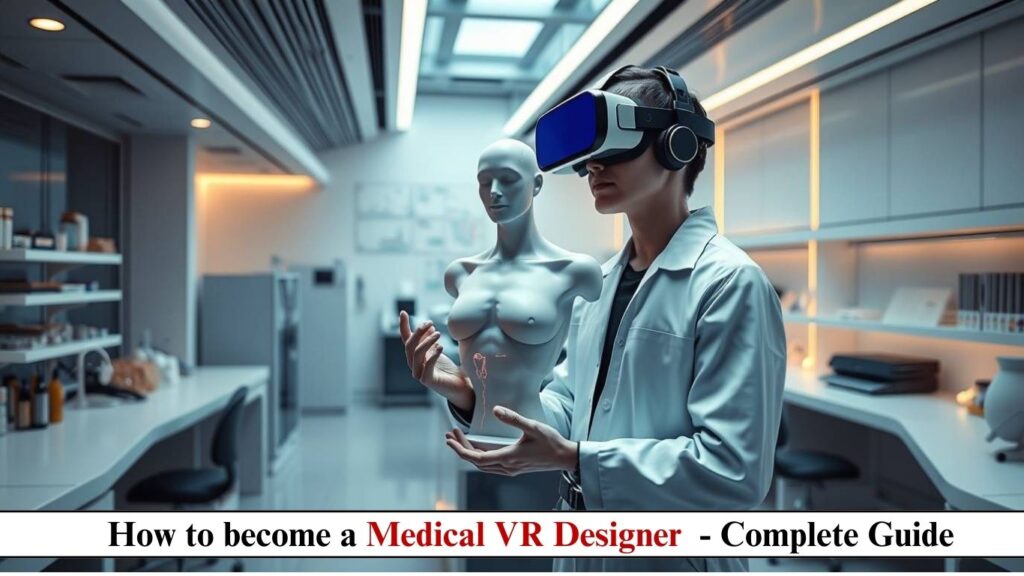
Introduction
The healthcare industry is undergoing a digital revolution, and Medical Virtual Reality (VR) Designers are at the forefront. These professionals blend healthcare knowledge, 3D modeling, and interactive design to create immersive simulations for medical training, patient therapy, and surgical planning.
In this comprehensive guide, we’ll cover:
- The history of medical VR
- Salary expectations
- Roles & responsibilities
- Required qualifications
- How to get started
- Future scope & career growth
Whether you’re a programmer, 3D artist, or healthcare professional, this guide will help you break into this cutting-edge field.
History of Medical Virtual Reality
Early Beginnings (1960s–1990s)
- 1962: Morton Heilig created the Sensorama, an early VR prototype.
- 1980s: NASA and the military used VR for flight simulations and trauma training.
- 1990s: First VR surgical simulators emerged but were limited by high costs.
Growth Phase (2000s–2010s)
- 2005: Stanford University used VR for phantom limb pain therapy.
- 2010s: Oculus Rift and HTC Vive made VR affordable for medical training.
- 2016: Osso VR launched, revolutionizing surgical simulation.
Modern Era (2020s–Present)
- COVID-19 accelerated VR adoption for remote training.
- AI + VR integration improved personalized patient rehab.
- Hospitals now use VR for PTSD therapy, pain management, and anatomy education.
Medical VR Designer Salary: How Much Do They Earn?
Salaries vary by experience, location, and industry:
| Experience Level | Average Salary (U.S.) |
|---|---|
| Entry-Level | $60,000 – $80,000 |
| Mid-Career | $80,000 – $120,000 |
| Senior-Level | $120,000 – $150,000+ |
Factors Affecting Salary:
✔ Industry:
- Healthcare Tech Companies (highest pay)
- Hospitals & Medical Schools
- VR Startups & Research Labs
✔ Location:
- Silicon Valley, Boston, NYC pay more than rural areas.
- Remote work is common in this field.
✔ Skills:
- Unity/Unreal Engine expertise increases pay.
- Medical knowledge (anatomy, surgery) is a plus.
Roles & Responsibilities of a Medical VR Designer
1. Designing Medical Simulations
- Create 3D surgical training modules (e.g., laparoscopic surgery).
- Develop patient rehab games (stroke recovery, physical therapy).
2. Collaborating with Healthcare Professionals
- Work with doctors, surgeons, and medical educators to ensure accuracy.
- Test VR applications with medical students and patients.
3. Programming & Development
- Use Unity, Unreal Engine, or WebXR to build interactive VR environments.
- Implement haptic feedback for realistic touch sensations.
4. User Experience (UX) Design
- Ensure VR interfaces are intuitive for doctors and patients.
- Optimize for motion sickness reduction.
5. Research & Innovation
- Stay updated on AI-driven VR diagnostics.
- Experiment with augmented reality (AR) for mixed-reality surgeries.
Qualifications Needed to Become a Medical VR Designer
1. Educational Background
- Bachelor’s Degree in:
- Computer Science / Game Design (for programming & 3D modeling)
- Biomedical Engineering / Healthcare (for medical applications)
- Master’s in Human-Computer Interaction (HCI) or VR Development (optional but beneficial).
2. Technical Skills
✔ 3D Modeling:
- Blender, Maya, or ZBrush for medical anatomy models.
✔ Programming: - C# (Unity) or C++ (Unreal Engine).
✔ VR/AR Development: - Oculus SDK, SteamVR, or ARKit.
✔ Medical Knowledge (Bonus): - Anatomy, surgical procedures, or physical therapy basics.
3. Certifications (Optional but Helpful)
- Unity Certified 3D Artist
- Google AR & VR Certification
- Medical Simulation Certification (for healthcare-focused roles)
How to Get Started as a Medical VR Designer
Step 1: Learn the Core Skills
- Take online courses:
- Udemy: “VR Development with Unity”
- Coursera: “Medical VR & AR Applications”
- Practice 3D modeling (start with free tools like Blender).
Step 2: Build a Portfolio
- Create medical VR demos (e.g., a virtual anatomy lab or surgery sim).
- Contribute to open-source healthcare VR projects on GitHub.
Step 3: Gain Experience
- Intern at VR studios or hospitals with simulation labs.
- Freelance on platforms like Upwork (search for “medical VR projects”).
Step 4: Apply for Jobs
- Look for roles like:
- “Medical VR Developer”
- “Healthcare Simulation Designer”
- “XR Medical Engineer”
- Top employers: Osso VR, Surgical Theater, Oxford VR, and major hospitals.
Future Scope of Medical VR Designers
1. Expansion in Surgical Training
- Haptic gloves & AI tutors will make VR surgery practice more realistic.
2. Mental Health & Pain Management
- VR is being used for PTSD therapy, anxiety relief, and chronic pain distraction.
3. Remote Medical Consultations
- Metaverse clinics could allow doctors to interact with patients in VR.
4. AI + VR Diagnostics
- Machine learning will help VR systems predict surgical risks.
5. Global Job Growth
- The VR healthcare market is projected to hit $7 billion by 2027 (Grand View Research).
Conclusion: Is Medical VR Design Right for You?
✅ Best For:
- Game developers wanting to transition into healthcare.
- Medical professionals interested in tech innovation.
- 3D artists & programmers seeking a high-impact career.
🚀 Next Steps:
- Learn Unity/Unreal Engine.
- Build a medical VR demo.
- Network with healthcare VR communities.
- Apply for internships or freelance gigs.
With VR transforming medicine, skilled designers will be in high demand. Start your journey today!
Did you find this guide helpful? Let us know in the comments! 💬👇
Would you like recommendations for medical VR development tools? Drop a question below!













Post Comment